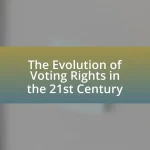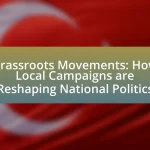The article examines the critical role of polling in elections, focusing on its impact on voter decision-making, accuracy, and potential biases. It outlines how polling influences public opinion, shapes campaign strategies, and affects perceptions of candidate viability through mechanisms like the bandwagon effect. The discussion includes various polling methods, factors contributing to polling accuracy, and the implications of misinterpretation and bias in polling results. Additionally, it highlights best practices for interpreting polling data and the importance of reliable sources, ultimately emphasizing the need for informed voter engagement with polling information.
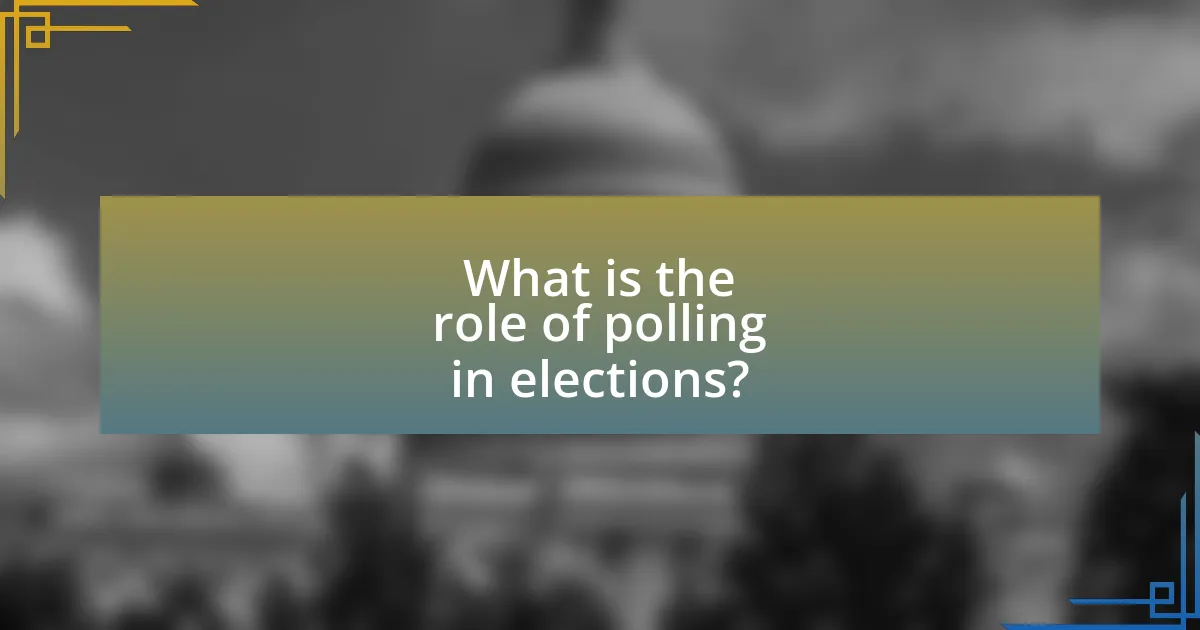
What is the role of polling in elections?
Polling plays a crucial role in elections by gauging public opinion and predicting electoral outcomes. It provides candidates, parties, and analysts with insights into voter preferences, allowing them to tailor their campaigns effectively. For instance, during the 2020 U.S. presidential election, numerous polls indicated a lead for Joe Biden, which influenced campaign strategies and voter mobilization efforts. Accurate polling can reflect the electorate’s mood, while biased or poorly conducted polls may misrepresent public sentiment, leading to misguided strategies. Thus, the integrity and methodology of polling are vital for its effectiveness in shaping electoral dynamics.
How do polls influence voter perceptions?
Polls influence voter perceptions by shaping public opinion and creating a sense of momentum for candidates. When polls indicate a candidate is leading, it can enhance that candidate’s perceived viability, leading undecided voters to support them due to the bandwagon effect. Research shows that voters often rely on polls as a heuristic for decision-making, particularly when they lack detailed information about candidates or issues. For instance, a study by the Pew Research Center found that 60% of voters consider poll results when making their choices, indicating that polling data significantly impacts voter behavior and perceptions of candidate electability.
What types of polls are commonly used in elections?
Common types of polls used in elections include opinion polls, exit polls, and tracking polls. Opinion polls gauge public sentiment on candidates or issues at a specific time, often using random sampling methods to ensure accuracy. Exit polls are conducted immediately after voters cast their ballots, providing insights into voter demographics and preferences, which can help predict election outcomes. Tracking polls measure changes in public opinion over time by surveying the same group of respondents at regular intervals. These polling methods are essential for understanding voter behavior and shaping campaign strategies.
How do different polling methods affect results?
Different polling methods significantly affect results by influencing the accuracy, bias, and representativeness of the data collected. For instance, telephone surveys may yield different results compared to online polls due to varying demographics and response rates; research indicates that younger voters are more likely to respond to online surveys, potentially skewing results toward their preferences. Additionally, the wording of questions can introduce bias, as shown in studies where slight changes in phrasing led to different levels of support for candidates. A 2016 study by Pew Research Center found that polls using live interviewers produced results that were more accurate than those relying solely on automated systems, highlighting the importance of methodology in capturing public opinion accurately.
Why is accuracy important in polling?
Accuracy is crucial in polling because it ensures that the data collected reflects the true opinions and preferences of the population. When polling data is accurate, it provides reliable insights that can influence decision-making for candidates, parties, and policymakers. For instance, a 2020 study by the American Association for Public Opinion Research found that accurate polls can predict election outcomes with a margin of error as low as 2-3%, which is essential for understanding voter behavior and shaping campaign strategies. Inaccurate polling, on the other hand, can lead to misguided strategies and misinterpretation of public sentiment, ultimately affecting the democratic process.
What factors contribute to polling accuracy?
Polling accuracy is influenced by several key factors, including sample size, sampling method, question wording, and timing of the poll. A larger sample size generally leads to more reliable results, as it reduces the margin of error; for instance, a poll with 1,000 respondents typically has a margin of error of about 3%. The sampling method, whether random or stratified, affects representativeness; random sampling minimizes bias, while stratified sampling ensures specific demographic groups are adequately represented. Additionally, the wording of questions can introduce bias or lead respondents to certain answers, impacting the validity of the results. Finally, the timing of the poll is crucial, as public opinion can shift rapidly due to current events or campaign activities, making timely data collection essential for accuracy.
How can inaccuracies in polling impact election outcomes?
Inaccuracies in polling can significantly distort election outcomes by misrepresenting voter preferences and influencing campaign strategies. When polls inaccurately predict the support for candidates, they can lead to misguided resource allocation, where campaigns may focus on areas perceived as competitive based on flawed data. For instance, the 2016 U.S. presidential election saw several polls underestimating Donald Trump’s support, which contributed to unexpected results in key battleground states. Additionally, inaccurate polling can create a bandwagon effect, where voters may be swayed to support a candidate perceived as the frontrunner, further skewing the actual voter turnout. This interplay between polling inaccuracies and voter behavior underscores the critical role that reliable polling plays in shaping electoral dynamics.
What biases can affect polling results?
Polling results can be affected by several biases, including selection bias, response bias, and question wording bias. Selection bias occurs when the sample surveyed does not accurately represent the population, leading to skewed results; for instance, polling only registered voters may exclude significant segments of the population. Response bias arises when respondents do not answer questions truthfully or accurately, often influenced by social desirability or fear of judgment. Question wording bias happens when the phrasing of questions leads respondents toward a particular answer, which can distort the true sentiment of the population. These biases can significantly impact the reliability of polling data, as evidenced by instances where polls failed to predict election outcomes due to these factors.
How does question wording influence poll responses?
Question wording significantly influences poll responses by shaping how respondents interpret and engage with the questions. For instance, leading questions can prompt specific answers, while neutral wording encourages more honest and varied responses. Research by the Pew Research Center indicates that slight changes in wording can lead to different outcomes; for example, asking if respondents “support” a policy versus if they “favor” it can yield different levels of approval. This demonstrates that the phrasing of questions can introduce bias, affecting the accuracy of polling data and ultimately influencing voter decision-making.
What role does sample selection play in polling bias?
Sample selection is critical in determining polling bias, as it directly influences the representativeness of the survey results. When a sample is not representative of the broader population, it can lead to skewed results that do not accurately reflect public opinion. For instance, if a poll disproportionately includes respondents from a specific demographic group, such as age or socioeconomic status, the findings may misrepresent the views of the entire population. Research has shown that polls with inadequate sample selection can produce biases of up to 5% or more, significantly affecting the accuracy of predictions in electoral outcomes. Therefore, careful consideration of sample selection is essential to minimize polling bias and ensure reliable data.
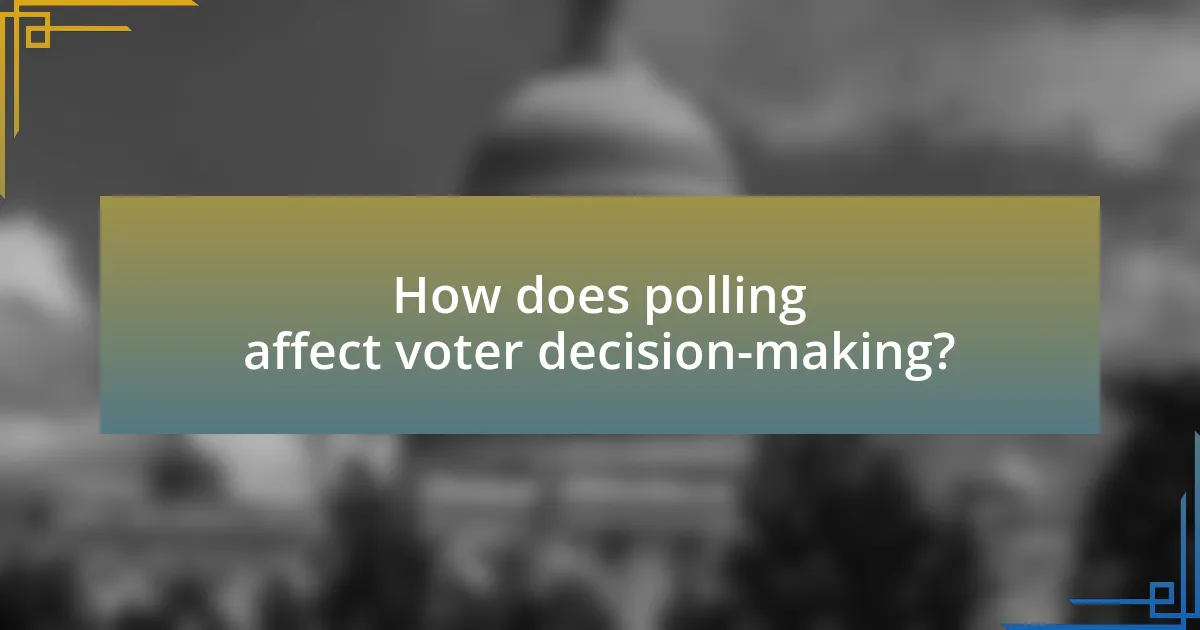
How does polling affect voter decision-making?
Polling significantly influences voter decision-making by shaping perceptions of candidate viability and public opinion. When voters see polling data indicating a candidate’s strong performance, they may be more likely to support that candidate, believing they have a better chance of winning. Research shows that voters often rely on polls as a heuristic, particularly when they are undecided, leading to a bandwagon effect where support shifts toward leading candidates. For instance, a study published in the American Political Science Review found that voters are more likely to change their preferences based on polling information, especially in competitive races. This demonstrates that polling not only reflects but actively shapes electoral dynamics and voter behavior.
What psychological effects do polls have on voters?
Polls significantly influence voters’ psychological states, primarily through the concepts of social proof and bandwagon effects. When voters perceive that a candidate is leading in polls, they may feel compelled to support that candidate to align with the majority, which can enhance the candidate’s perceived legitimacy. Research indicates that this phenomenon can lead to increased voter turnout for leading candidates, as individuals often desire to be part of a winning group. Additionally, polls can create a sense of urgency or anxiety among voters for candidates trailing in the polls, potentially demotivating their supporters. A study by the Pew Research Center found that 60% of voters reported being influenced by polling data, highlighting the substantial psychological impact polls have on voter behavior and decision-making.
How do polls create a bandwagon effect?
Polls create a bandwagon effect by influencing voter perceptions of candidate popularity, leading individuals to align their choices with perceived majority preferences. When polls indicate that a particular candidate is leading, potential voters may feel compelled to support that candidate to be part of the winning group, driven by social proof and the desire for acceptance. Research has shown that individuals are more likely to change their voting intentions based on poll results, as evidenced by a study published in the Journal of Politics, which found that exposure to favorable poll results for a candidate increased their support among undecided voters. This demonstrates how polling can shape electoral dynamics by reinforcing the notion that a candidate is the preferred choice among the electorate.
What is the impact of negative polling on candidates?
Negative polling significantly impacts candidates by influencing public perception and voter behavior. When candidates receive unfavorable polling results, it can lead to decreased support, as voters often prefer to back perceived winners. Research indicates that negative polling can create a self-fulfilling prophecy, where candidates struggle to gain traction due to the perception of weakness, as seen in the 2016 U.S. presidential election, where early negative polling affected candidates’ fundraising and media coverage. Additionally, negative polling can demoralize campaign staff and supporters, further diminishing a candidate’s chances of success.
How do media portrayals of polls influence public opinion?
Media portrayals of polls significantly influence public opinion by shaping perceptions of candidate viability and voter sentiment. When media outlets report on polls, they often highlight leading candidates, which can create a bandwagon effect, encouraging voters to support those perceived as frontrunners. For instance, a study by the Pew Research Center found that when polls show a candidate leading, it can lead to increased support due to the perception of electability. Additionally, the framing of poll results—such as emphasizing a narrow margin or a surprising upset—can sway public perception and voter behavior. This influence is further amplified by the frequency and context in which polls are presented, as consistent coverage can reinforce certain narratives and impact voter decisions.
What role does social media play in disseminating polling information?
Social media serves as a crucial platform for disseminating polling information by enabling rapid sharing and broad reach to diverse audiences. It allows polling organizations and media outlets to publish results instantly, facilitating real-time engagement and discussion among users. According to a Pew Research Center study, 53% of Americans report getting news from social media, highlighting its significant role in shaping public perception of polling data. Additionally, social media algorithms prioritize content that generates engagement, which can amplify the visibility of polling information, influencing voter decision-making and perceptions of electoral candidates.
How can misinterpretation of polls lead to misinformation?
Misinterpretation of polls can lead to misinformation by distorting the actual sentiments of the population. When poll results are inaccurately reported or understood, they can create a false narrative about public opinion, influencing voter perceptions and decisions. For instance, if a poll indicates that a candidate has a slight lead but is reported as a significant advantage, voters may be misled into believing that the candidate is more popular than they actually are. This can result in skewed expectations and behaviors, such as increased support for the leading candidate based on erroneous interpretations. Historical examples, such as the misinterpretation of polling data in the 2016 U.S. presidential election, illustrate how misleading narratives can emerge from misunderstood poll results, ultimately affecting voter turnout and election outcomes.
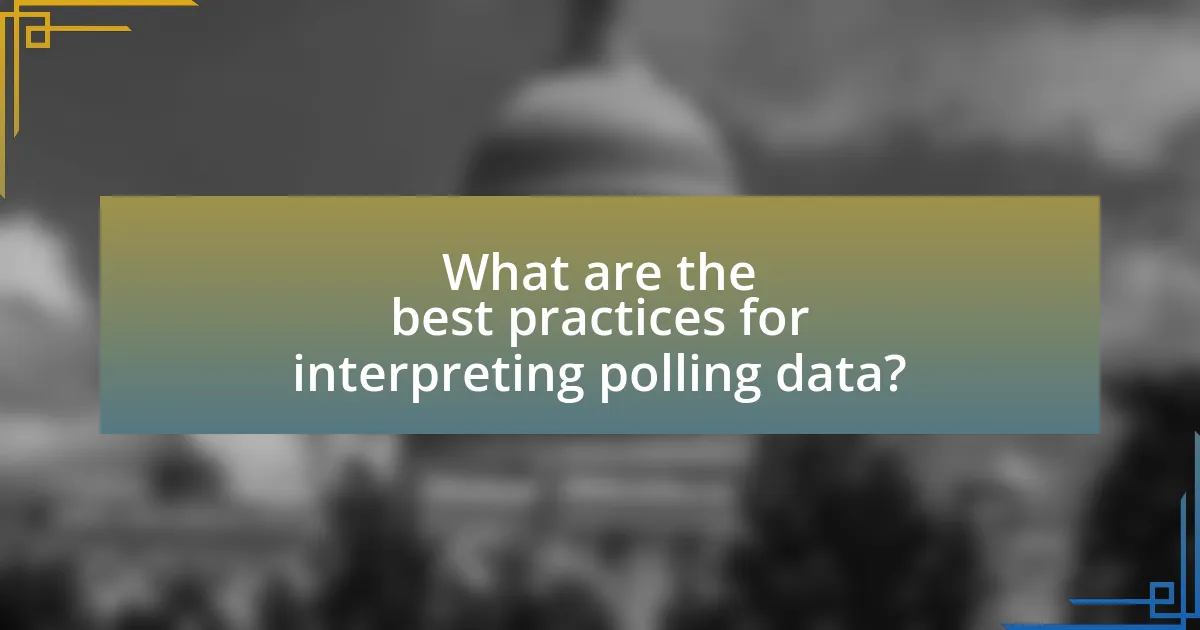
What are the best practices for interpreting polling data?
The best practices for interpreting polling data include understanding the methodology, considering sample size, and recognizing potential biases. Methodology refers to how the poll was conducted, including question wording and order, which can significantly influence results. A sample size of at least 1,000 respondents is generally considered reliable for national polls, as smaller samples can lead to larger margins of error. Additionally, awareness of biases, such as selection bias or response bias, is crucial, as these can distort the representation of public opinion. For instance, a 2020 Pew Research Center study highlighted that polls with transparent methodologies and larger sample sizes tend to yield more accurate predictions of election outcomes.
How can voters critically assess polling information?
Voters can critically assess polling information by examining the methodology, sample size, and potential biases of the polls. Methodology refers to how the poll was conducted, including whether it used random sampling, which is crucial for accuracy; for instance, a poll conducted with a sample size of at least 1,000 respondents typically provides a more reliable estimate of public opinion. Sample size impacts the margin of error, with larger samples generally yielding more precise results. Additionally, voters should consider the source of the poll, as reputable organizations like Pew Research Center or Gallup adhere to rigorous standards, while less credible sources may not. Recognizing potential biases, such as leading questions or demographic imbalances, is essential for understanding the context of the results. By analyzing these factors, voters can make informed judgments about the reliability and relevance of polling data in the electoral process.
What key indicators should voters look for in polls?
Voters should look for sample size, margin of error, and demographic representation as key indicators in polls. A larger sample size generally increases the reliability of the poll results, while a smaller margin of error indicates greater precision in the estimates. Additionally, demographic representation ensures that the poll reflects the diversity of the electorate, which is crucial for accurate predictions. For instance, a poll with a sample size of 1,000 respondents and a margin of error of ±3% is typically considered more reliable than one with a sample size of 300 and a margin of error of ±5%.
How can voters identify reliable polling sources?
Voters can identify reliable polling sources by evaluating the methodology, sample size, and transparency of the polling organization. Reliable polls typically disclose their sampling methods, including how participants are selected and the size of the sample, which should ideally be at least 1,000 respondents to ensure statistical significance. Additionally, reputable polling organizations, such as Gallup or Pew Research Center, adhere to rigorous standards and are often transparent about their funding sources and potential biases. According to a 2020 study by the American Association for Public Opinion Research, polls that follow these best practices tend to produce more accurate results, reinforcing the importance of scrutinizing the credibility of polling sources.
What strategies can enhance understanding of polling data?
To enhance understanding of polling data, individuals can employ strategies such as analyzing the methodology behind the polls, examining sample sizes, and considering the timing of the polls. Understanding the methodology, including how questions are framed and the demographic representation of respondents, provides insight into potential biases and the reliability of the results. For instance, a poll with a sample size of 1,000 respondents typically has a margin of error of about 3%, which can significantly impact the interpretation of results. Additionally, recognizing that polls conducted closer to an election may reflect more current public sentiment can help contextualize the data. These strategies collectively enable a more informed interpretation of polling data, reducing the likelihood of misinterpretation and enhancing overall comprehension.
How can educational resources improve public literacy on polling?
Educational resources can improve public literacy on polling by providing clear, accessible information about polling methodologies, data interpretation, and the significance of polling in the electoral process. For instance, educational programs that explain how polls are conducted, including sampling techniques and question framing, help individuals critically assess the reliability of polling data. Research indicates that informed voters are better equipped to understand the implications of polling results on voter behavior and decision-making, as highlighted in studies by the Pew Research Center, which found that increased knowledge about polling correlates with more informed voting choices. By enhancing understanding of these concepts, educational resources empower citizens to engage more thoughtfully with polling data, ultimately fostering a more informed electorate.
What tools are available for analyzing polling data effectively?
Tools available for analyzing polling data effectively include statistical software such as R, Python, and SPSS. R and Python offer extensive libraries for data manipulation and statistical analysis, enabling users to perform complex analyses and visualize results. SPSS provides a user-friendly interface for conducting various statistical tests and generating reports. Additionally, platforms like Tableau and Microsoft Power BI facilitate data visualization, making it easier to interpret polling trends and patterns. These tools are widely used in the field of political science and market research, demonstrating their effectiveness in analyzing polling data.




